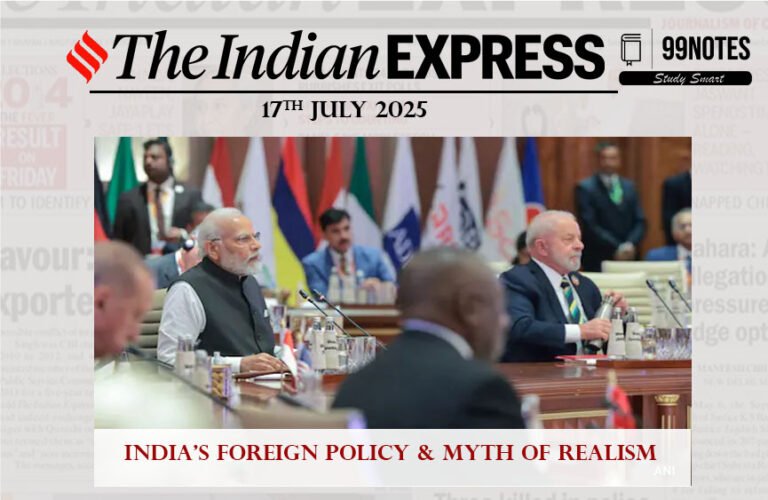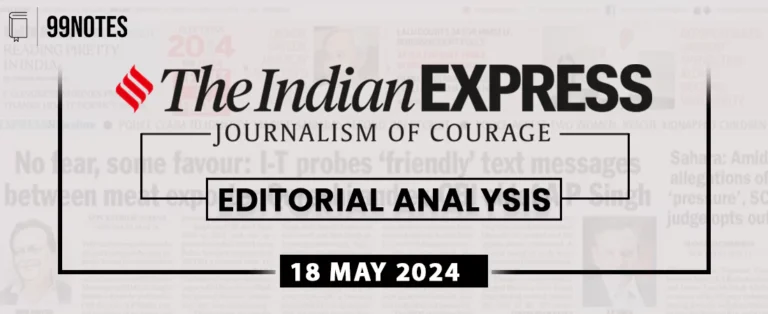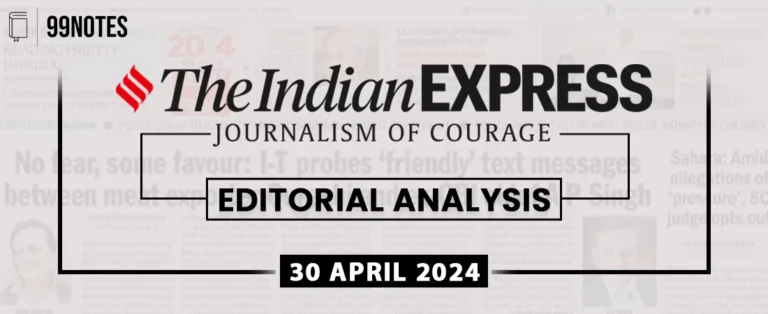27 March 2024 : Indian Express Editorial Analysis
Indian Express Editorial Analysis
27-March-2024
1. Don’t blame it on wokeness
Topic: GS2 – Social Justice – Health
This topic is relevant for both Prelims and Mains as this article provides insights into the prevalence of mental health issues in India and globally, shedding light on a significant social issue.
| Context: |
|
Global Rise in Mental Health Issues:
- Depression and related mental health disorders are not unique to India; they are part of a global trend.
- While various factors contribute to this epidemic, a new study suggests that social awareness might play a significant role, particularly among the so-called “woke” individuals.
Impact of Social Awareness on Mental Health:
- The article delves into how awareness of social issues influences mental well-being.
- It argues that exposure to various life events, diverse perspectives, and awareness of privilege shape individuals’ worldviews and emotional responses.
- The article highlights the importance of education in fostering empathy and critical thinking, challenging the notion that social awareness directly causes depression.
Interplay of Political Awareness and Mental Health:
- While some studies suggest that political awareness contributes to depression, the author argues that it’s not awareness per se but rather the realization of societal injustices and power imbalances that can lead to despair.
- The complexity of socioeconomic disparities, intertwined with issues of race, gender, and sexuality, exacerbates mental health challenges, especially in countries like India.
Conclusion:
- The article concludes by emphasizing the importance of acknowledging the human dimension in discussions about mental health.
- It argues that while political awareness can contribute to distress, it’s ultimately the inability to effect change in the face of social injustices that leads to feelings of depression and anxiety.
- Thus, the need for a more nuanced understanding of mental health issues and their intersection with broader societal issues remains paramount.
| What are the Government initiatives on mental health? |
|
|
| Practice Question: Discuss the prevalence of depression in India as revealed by the 2015-16 National Mental Health Survey, highlighting the potential factors contributing to this epidemic. (150 words/10 m) |
2. The devil is in the footnote
|
Topic: GS3 – Indian Economy – Inclusive growth This topic is relevant for both Prelims and Mains in the context of knowing facts about the discussion surrounding income distribution, methodology in economic research, and the implications for policy. |
| Context: |
|
Importance of Reliable Data:
- The absence of comprehensive income distribution surveys in India has been a long-standing issue, despite recommendations from experts.
- The lack of such surveys hampers accurate assessments of income distribution, particularly concerning marginalized populations such as the billionaire elite, who often remain unaccounted for in traditional surveys.
Role of Piketty and the World Inequality Lab:
- Piketty and his colleagues at the World Inequality Lab have made significant contributions to the study of income inequality, popularizing indices such as the share of income held by the top X percent of the population.
- However, their methodology has faced scrutiny, particularly regarding the merging of tax and non-survey data with survey data to estimate income distribution.
Concerns about Methodological Assumptions:
- Critics have raised concerns about the validity of assumptions made by Piketty and the WIL in estimating income distribution.
- The upward revisions of income share estimates, as documented in the case of India, raise questions about the reliability of their findings.
- Such substantial revisions over relatively short periods call into question the robustness of the underlying methodology.
Criticisms and Alternative Perspectives:
- Various scholars have criticized Piketty’s methodology, citing errors, opaque methodological choices, and cherry-picking of sources.
- Additionally, alternative studies suggest differing trends in income inequality, challenging Piketty’s conclusions.
Implications for Policy:
- Policy recommendations based on questionable statistical estimates risk misallocation of resources.
- Calls for super taxes on billionaires and multimillionaires, while appealing to populist sentiments, should be grounded in accurate data and careful analysis to avoid unintended consequences.
Need for Critical Analysis:
- The uncritical acceptance of conclusions based on flawed data highlights the importance of rigorous analysis and scrutiny in academic and policy circles.
- It is essential to question assumptions, examine methodologies, and prioritize accuracy in data-driven research to ensure informed policy decisions and meaningful social discourse.
| About World Inequality Lab |
|
| Practice Question: What are the methodological challenges highlighted in the recent paper by the World Inequality Lab regarding the estimation of income distribution in India? Discuss the potential implications of these challenges for the reliability of the findings and their impact on policy decisions. (250 words/15 m) |
For Enquiry

27 March 2024 : Indian Express Editorial Analysis

27 March 2024 : PIB Summary for UPSC

27 March 2024 : The Hindu Editorial Notes PDF

26 Mar 2024 : Daily Current Affairs Quiz

26 Mar 2024 : Daily Answer Writing

26 March 2024 : PIB Summary for UPSC

26 March 2024 : Daily Current Affairs

26 March 2024 : Indian Express Editorial Analysis

26 March 2024 : The Hindu Editorial Notes PDF

23 Mar 2024 : Daily Current Affairs Quiz
Indian Express 27 March 2024 : Indian Express Editorial Analysis Indian Express Editorial Analysis
27-March-2024
1. Don’t blame it on wokeness
Topic: GS2 – Social…
March 2024 PIB 27 March 2024 : PIB Summary for UPSC PIB Summary for UPSC
27-March -2024
1. As part of overseas deployment to ASEAN countries, ICG Ship Samudra…
March – The Hindu Editorial 27 March 2024 : The Hindu Editorial Notes PDF The Hindu EDITORIAL
27-March-2024
1. A cry for help, a call for reflection and action
Topic: GS2…
Daily Quiz 26 Mar 2024 : Daily Current Affairs Quiz 26 Mar 2024 : Daily Quiz…
mains answer writing 26 Mar 2024 : Daily Answer Writing Mains Answer Writing
26-March-2024
Q1) The Jal Jeevan Mission needs meticulous coordination and collaboration…
March 2024 PIB 26 March 2024 : PIB Summary for UPSC PIB Summary for UPSC
26-March -2024
1. Payroll Data: EPFO adds 16.02 lakh net members during January…
Daily Current Affairs 26 March 2024 : Daily Current Affairs Daily Current Affairs
26-March -2024- Top News of the Day
1. EU probe into tech giants for ‘violation’…
Indian Express 26 March 2024 : Indian Express Editorial Analysis Indian Express Editorial Analysis
26-March-2024
1. WTO’S EXISTENTIAL CRISIS
Topic: GS2 – International…
March – The Hindu Editorial 26 March 2024 : The Hindu Editorial Notes PDF The Hindu EDITORIAL
26-March-2024
1. China, a ‘want-to-be’ superpower
Topic: GS2 – International…
Daily Quiz 23 Mar 2024 : Daily Current Affairs Quiz 23 Mar 2024 : Daily Quiz…




